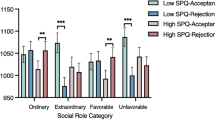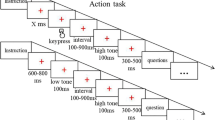Abstract
Schizotypal personality disorder (SPD) is characterized by eccentric behavior and perceptual distortions that closely resemble the patterns observed in those with schizophrenia. Schizophrenia and related personality disorders (i.e., SPD) are associated with deficits in sustained attention, slower than normal reaction times, and manifestations of working memory deficits and erratic cognitive tasks. The present study used the schizotypal personality scale (STA) to compare cognitive abilities of self-reported low schizotypic tendency subjects with high schizotypic tendency subjects. The group scores on the STA differed significantly. Those with high STA scores also tended to have higher state and trait anxiety scores based on the State-Trait Anxiety Inventory (STAI). The groups did not significantly differ on any of the demographic variables tested, including age, education, self-rated health status, and medication. Along with an executive function test, two computerized tasks tested subjects on reaction time and memory. Even when covariates (i.e., state, trait anxiety scores) were analyzed, there were no significant differences between the groups and tasks, although the gathered data showed trends in the expected direction.
Similar content being viewed by others
References
Andreasen, N. C., & Flaum, M. (1991). Schizophrenia: The characteristic symptoms. Schizophrenia Bulletin, 17(1), 27–49.
Appels, M. C. M., Sitskoorn, M. M., Vollema, M. G., & Kahn, R. S. (2004). Elevated levels of schizotypal features in parents of patients with a family history of schizophrenia spectrum disorders. Schizophrenia Bulletin, 30(4), 781–790.
Bergida, H., & Lenzenweger, M. F. (2006). Schizotypy and sustained attention: Confirming evidence from an adult community sample. Journal of Abnormal Psychology, 115(3), 545–551.
Braunstein-Bercovitz, H. (2000). Is the attentional dysfunction in schizotypy related to anxiety. Schizophrenia Research, 46, 255–267.
Braunstein-Bercovitz, H. (2003). The modulation of latent inhibition by field-dependency: Is it related to the attentional dysfunction in schizotypy. Personality and Individual Differences, 35, 1719–1729.
Carlson, N. R. (2004). Physiology of behavior (8th ed.). Boston: Pearson Education.
De Houwer, J., Crombez, G., Baeyen, F., & Hermans, D. (2001). On the generality of the affective Simon Effect. Cognition and Emotion, 15(2), 189–206.
Dempster, F. N. (1991). Inhibitory processes: A neglected dimension of intelligence. Intelligence, 15, 157–173.
Erlenmeyer-Kimling, L., Rock, D., Roberts, S. A., Janal, M., Kestenbaum, C., Cornblatt, B., et al. (2000). Attention, memory, and motor skills as childhood predictors of schizophrenia-related psychoses: The New York High Risk Project. American Journal of Psychiatry, 157, 1416–1422.
Eysenck, M. W. (1992). Anxiety: The cognitive perspective. Hove, UK: Lawrence Erlbaum Associates.
Ferraro, R., & Okerlund, M. (1996). Failure to inhibit irrelevant information in non-clinical schizotypal individuals. Journal of Clinical Psychology, 52(4), 389–394.
Francis, G., Neath, I., MacKewn, A., & Goldthwaite, D. (2004). CogLab on a CD [Computer software and manual]. Belmont, CA, USA: Wadsworth.
Frith, C. D. (1979). Consciousness, information processing and schizophrenia. The British Journal of Psychiatry, 134, 225–235.
Fuller, R. L., Luck, S. J., McMahon, R. P., & Gold, J. M. (2005). Working memory consolidation is abnormally slow in schizophrenia. Journal of Abnormal Psychology, 114(2), 279–290.
Goldberg, T. E., David, A., & Gold, J. M. (2003). Neurocognitive deficits in schizophrenia. In S. R. Hirsch, & D. R. Weinberger (Eds.) Schizophrenia ((pp. 34–53)2nd ed.). Malden, MA, USA: Blackwell.
Gooding, D. C., Matts, C. W., & Rollmann, E. A. (2006). Sustained attention deficits in relation to psychometrically identified schizotypy: Evaluating a potential endophenotypic marker. Schizophrenia Research, 82, 27–37.
Heinrichs, R. W. (2005). The primacy of cognition in schizophrenia. American Psychologist, 60(3), 229–242.
Hoff, E. R., & Ferraro, F. R. (2005). Creativity, intelligence, cognitive inhibition, and thought organization: Links among a non-clinical schizotypal population. Psi Chi Journal of Undergraduate Research, 10(1), 32–37.
Hughes, C., Kumari, V., Das, M., Zachariah, E., Ettinger, U., Sumich, A., et al. (2005). Cognitive functioning in siblings discordant for schizophrenia. Acta Psychiatrica Scandinavica, 111, 185–192.
Huppert, J. D., & Smith, T. E. (2005). Anxiety and schizophrenia: The interaction of subtypes of anxiety and psychotic symptoms. CNS Spectrums, 10(9), 721–731.
Jackson, M., & Claridge, G. (1991). Reliability and validity of a psychotic traits questionnaire (STQ). British Journal of Clinical Psychology, 30(4), 311–323.
Julien, R. M. (2005). A primer of drug action (10th ed.). New York: Worth Publishers.
Keefe, R. S. E. (2001). Neurocognition. In A. Breier, P. V. Tran, J. M. Herrera, G. D. Tollefson, & F. P. Bymaster (Eds.) Current issues in the psychopharmacology of schizophrenia (pp. 192–205). Philadelphia: Lippincott Williams & Wilkins.
Kety, S. S., Rosenthal, D., Wender, P. H., & Schulsinger, F. (1971). Mental illness in the biological and adoptive families of adopted schizophrenics. American Journal of Psychiatry, 128, 302–306.
Lewandowski, K. E., Barrantes-Vidal, N., Nelson-Gray, R. O., Clancy, C., Kepley, H. O., & Kwapil, T. R. (2006). Anxiety and depression symptoms in psychometrically identified schizotypy. Schizophrenia Research, 83, 225–235.
Liotti, M., Dazzi, S., & Umilta, C. (1993). Deficits of the automatic orienting of attention in schizophrenic patients. Journal of Psychiatric Research, 27, 119–130.
MacLeod, C. M., & MacDonald, P. A. (2000). Interdimensional interference in the Stroop effect: Uncovering the cognitive and neural anatomy of attention. Trends in Cognitive Sciences, 4(10), 383–391.
Mathews, A., May, J., Mogg, K., & Eysenck, M. (1990). Attentional bias in anxiety: Selective search or defective filtering. Journal of Abnormal Psychology, 99(2), 166–173.
McNeely, H. E., West, R., Christensen, B. K., & Alain, C. (2003). Neurophysiological evidence for disturbances of conflict processing in patients with schizophrenia. Journal of Abnormal Psychology, 112(4), 679–688.
Merckelbach, H., & Giesbrecht, T. (2006). Subclinical dissociation, schizotypy, and traumatic distress. Personality and Individual Differences, 40, 365–374.
Meyer, T. D., & Blechert, J. (2005). Are there attentional deficits in people putatively at risk for affective disorders. Journal of Affective Disorders, 84, 63–72.
Moritz, S., & Andresen, B. (2004). Reduced negative priming in schizotypy: Failure to replicate. British Journal of Clinical Psychology, 43, 211–215.
Mueser, K. T., & Gingerich, S. (1994). Coping with schizophrenia: A guide for families. Oakland, CA, USA: New Harbinger Publications.
Nestor, P. G., Faux, S. F., McCarley, R. W., Penhune, V., Shenton, M. E., Pollak, S., et al. (1992). Attentional cues in chronic schizophrenia: Abnormal disengagement of attention. Journal of Abnormal Psychology, 101(4), 682–689.
O’Flynn, K., Gruzelier, J., Bergman, A., & Siever, L. J. (2003). The schizophrenia spectrum personality disorders. In S. R. Hirsch, & D. R. Weinberger (Eds.) Schizophrenia ((pp. 80–100)2nd ed.). Malden, MA, USA: Blackwell.
Oltmanns, T. F., & Neale, J. M. (1978). Distractibility in relation to other aspects of schizophrenic disorder. In S. Schwartz (Ed.) Language and Cognition in Schizophrenia (pp. 117–143). Hillsdale, NJ, USA: Lawrence Erlbaum Associates.
Pantelis, C., Barber, F. Z., Barnes, T. R. E., Nelson, H. E., Owen, A. M., & Robbins, T. W. (1999). Comparison of set-shifting ability in patients with chronic schizophrenia and frontal lobe damage. Schizophrenia Research, 37(3), 251–270.
Pull, C. B., Cloos, J. M., & Murthy, N. V. (2003). Atypical psychotic disorders. In S. R. Hirsch, & D. R. Weinberger (Eds.) Schizophrenia ((pp. 54–67)2nd ed.). Malden, MA, USA: Blackwell.
Reveley, M. A., & Deakin, J. F. W. (Eds.). (2000). The pharmacology of schizophrenia. New York: Oxford University Press.
Silver, H., & Feldman, P. (2005). Evidence for sustained attention and working memory in schizophrenia sharing a common mechanism. The Journal of Neuropsychiatry and Clinical Neurosciences, 17(3), 391–398.
Snyder, S. H. (1980). Biological aspects of mental disorder. New York: Oxford University Press.
Spielberger, C. D., Gorsuch, R. L., & Lushene, R. E. (1970). Test manual for the State-Trait Anxiety Inventory. Palo Alto, CA, USA: Consulting Psychologists.
Spinella, M. (2005). Self-rated executive function: Development of the executive function index. International Journal of Neuroscience, 115, 649–667.
Stroop, J. R. (1935). Studies of interference in serial verbal reactions. Journal of Experimental Psychology: General, 121, 15–23.
Sturgill, D. S., & Ferraro, F. R. (1997). Prediciting negative priming: Effects of schizotypy, cognitive failures, and anxiety. Personality and Individual Differences, 23(2), 291–304.
Sue, D., Sue, D., & Sue, S. (1990). Personality disorders and impulse control disorders. In D. Sue, D. Sue, & S. Sue (Eds.) Understanding abnormal behavior ((pp. 229–258)3rd ed.). Boston: Houghton Mifflin.
Thaker, G. K., & Carpenter Jr., W. T. (2001). Advances in schizophrenia. Nature Medicine, 7, 667–671.
Tsakanikos, E., & Reed, P. (2004). Latent inhibition and context change in psychometrically defined schizotypy. Personality and Individual Differences, 36, 1827–1839.
Weschler, D. J. (1981). Manual: Weschler Adult Intelligence Scale: Revised. New York: Psychological Corporation.
Author information
Authors and Affiliations
Corresponding author
Rights and permissions
About this article
Cite this article
Stelton, S., Ferraro, F.R. The Effect of Anxiety on the Cognitive Functioning in Non-clinical Schizotypal Individuals. Curr Psychol 27, 16–28 (2008). https://doi.org/10.1007/s12144-008-9021-2
Published:
Issue Date:
DOI: https://doi.org/10.1007/s12144-008-9021-2




